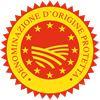Description
Prosciutto di Parma PDO is a raw, cured charcuterie product obtained through the processing of fresh thighs of pigs belonging to breeds registered in the Italian Herd Book, or those selected to be compatible with it.
Production Area
The production area of Prosciutto di Parma PDO is within parts of the territory of the Province of Parma, in the Emilia-Romagna region. The pigs are born and raised in the regions of Emilia-Romagna, Veneto, Lombardy, Piedmont, Molise, Umbria, Tuscany, The Marches, Abruzzo and Lazio.
Production Method
The pigs used must be at least nine months old, and their carcass must weigh between 110.1 and 168 kg. After slaughtering, the fresh legs are cooled for a whole day before being trimmed to obtain the characteristic rounded “chicken leg” shape, at the same time facilitating salting, for which only sea salt is used, without the addition of additives or preservatives. The fresh legs remain in the salt cells for 14 to 28 days. Once the salt has been removed, the legs are left to rest in rooms with the right humidity and temperature. As a whole, the salting and resting stages ("cold stages") must last at least 90 days, depending on the initial weight of the fresh leg and the progress of the processing. The leg of ham is then washed in potable water to remove any salt residue and impurities. During the pre-curing stage, the hams are hung on traditional wood frames called scalere, and left to dry in aerated rooms which traditionally have windows on either side; they are opened according to both the internal and external climatic conditions. Starting in the fifth month, the uncovered muscular mass, the groove around the fillet and any cracks are covered with the “sugna”, a thin layer of pig fat mixed with sea salt, ground pepper and perhaps rice flour. After the “sugnatura”, the hams are transferred to the curing rooms. Fourteen months from the start of production, certain tests are carried out by inspectors from the control body, including “sounding”, an olfactory test carried out with a horse bone needle. If the product is considered to be of the right quality, the leg is then fire branded with the “Ducal Crown”.
Appearance and Flavour
Prosciutto di Parma PDO has a roundish shape and no trotter. The lean part of the slice is pink, while the fat is white. It has a sweet and delicate taste and a fragrant aroma.
History
Prosciutto di Parma PDO boasts very ancient origins. The earliest information about ham processing in the Parma area dates back to the 2nd century BC, for example in De Agri Cultura, written by Marcus Porcius Cato. Polybius also wrote about ham and its production in Histories (2nd century BC), as did Quintus Horace Flaccus in Satires (1st century BC). Over the centuries, the testimonies multiplied, until – for the very first time – both the current "typical area" and the name Prosciutto di Parma were listed together in the 1913 chamber lists.
Gastronomy
Boned or whole Prosciutto di Parma PDO can be hung and stored in an environment with a temperature of between 17-20°C. The deboned packed product can be preserved for up to 6 months in a refrigerated environment, at a temperature no higher than 10°C. Once opened, it should be covered with a cloth or cling film. Prosciutto di Parma PDO should be thinly sliced and eaten either alone or accompanied by bread or the traditional torta fritta (deep-fried puff). It also goes well with fruit like melon and figs.
Marketing
The product is marketed as Prosciutto di Parma PDO. It is sold whole, deboned, in pieces or sliced, unpackaged, vacuum-packed or in atmosphere modified packaging.
Distinctive Features
Prosciutto di Parma PDO is a completely natural product: just Italian pig meat processed with sea salt. It is produced exclusively in a limited area in the Province of Parma, where the climatic conditions are ideal for curing, during which the ham acquires its distinctive characteristics, including its sweetness.


















































![[Langhirano] Il Festival del Prosciutto di Parma torna dal 6 all’8 settembre](https://www.qualivita.it/wp-content/uploads/2024/01/Prosciutto-di-Parma-DOP-Consorzio-Marchio-210x118.jpg)

